Catocala praeclara
kah-TOCK-uh-lahmpree-CLAIR-uh
Grote and Robinson, 1866

Catocala praeclara
courtesy of Cindy Mead, Michigan.
This site has been created by
Bill Oehlke at oehlkew@islandtelecom.com
Comments, suggestions and/or additional information are welcomed by Bill.
| TAXONOMY:
Superfamily: Noctuoidea
Family: Noctuidae
Group: Noctuinina
Subfamily: Catocalinae
Genus: Catocala, Schrank, 1802
| |
MIDI MUSIC
"Moon River"
copyright C. Odenkirk
MIDI CITYON.OFF
<bgsound src="moon.mid" LOOP=FOREVER>
|
DISTRIBUTION:
Catocala praeclara,
the Praeclara Underwing, (wingspan: 40-50mm) flies in Alberta,
Saskatchewan, Manitoba
Ontario, Quebec, New Brunswick and through
to Nova Scotia maybe??? in Canada.
Subspecies praeclara manitoba flies in Manitoba and Saskatchewan and in the US states of
North Dakota,
South Dakota and
Wyoming.
In the US nominate praeclara flies in Maine
south to Florida,
west to Kansas unconfirmed and Minnesota.
It has also been recorded in
Alabama,
Arkansas,
Connecticut,
Delaware,
Georgia,
Illinois,
Indiana,
Iowa,
Kentucky,
Louisiana,
Maryland,
Massachusetts,
Michigan,
Mississippi,
Montana,
New Hampshire,
New Jersey,
New York,
North Carolina,
North Dakota,
Ohio,
Pennsylvania,
Rhode Island,
South Carolina,
South Dakota,
Tennessee,
Texas,
Virginia,
West Virginia,
Wisconsin and
Wyoming.

Catocala praeclara, Monhegan Island, Maine,
September 1, 2006, courtesy of Steve Nanz.
The forewing is a pale greenish-grey with
considerable contrasting brown shading beyond post medial line.
There is a black basal dash very close to the inner margin and another
dash, higher up in the median area.
Note the contrasting shapes of the reniform and
subreniform spots.
The upper of the two larger teeth of the pm line is considerably longer and wider than the lower tooth.
Note double am line, internally filled with white.
There is a lighter, subcircular patch, outlined in black and brown on lower portion of thorax.
Catocala praeclara
courtesy of Canadian Biodiverstiy Information Facility
| 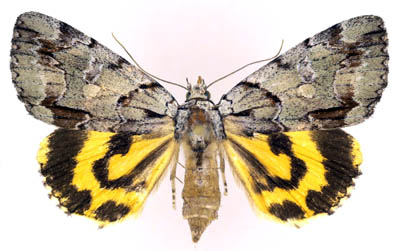
|
Vernon Brou writes, "Praeclara's forewings
can be silver, green or purple, depending on the locale across the
eastern US."
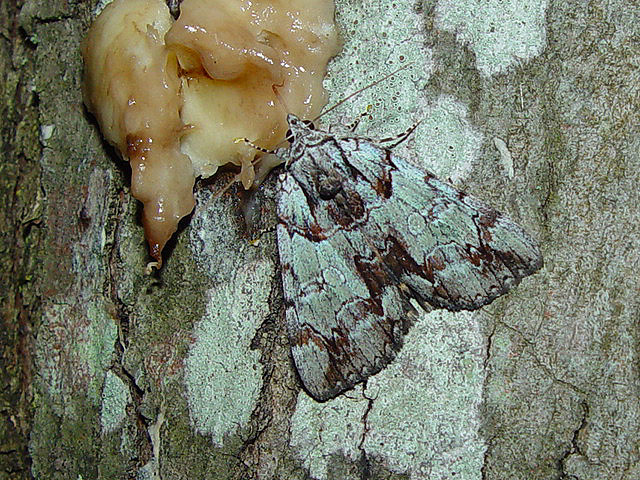
Catocala praeclara, July 21, 2006, Peterborough, Ontario, courtesy
of Tim Dyson.
FLIGHT TIMES AND PREFERRED FOOD PLANTS:
Catocala praeclara are usually on the wing from July to September.
The Catocala praeclara caterpillar shows a preference for chokeberry and juneberry.
With much patience Tim Dyson was able to lure this one to some mashed banana on a stick after it reported to a bedsheet below his cabin light.
Catocala praeclara, verso, July 21, 2006, Peterborough, Ontario,
courtesy
of Tim Dyson.
| 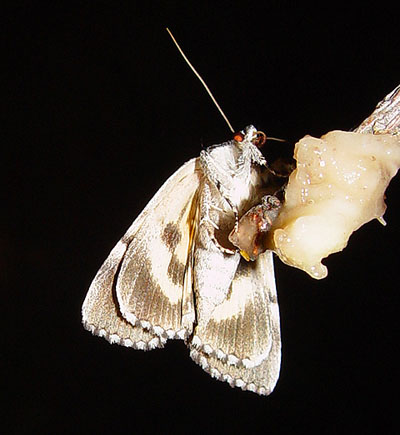
|
ECLOSION:
Adults eclose from pupae at soil surface.
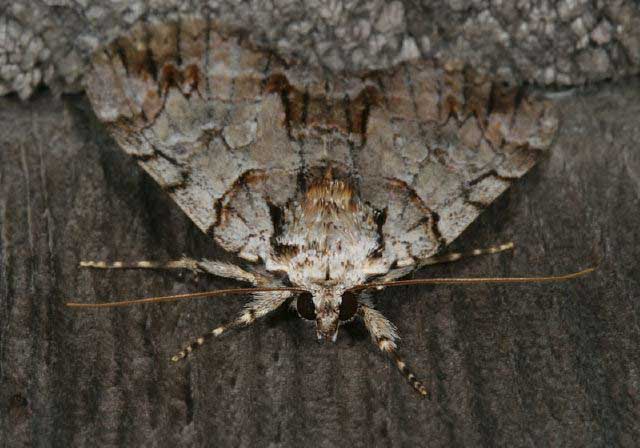
Catocala praeclara, Monhegan Island, Maine,
September 1, 2006, courtesy of Steve Nanz.
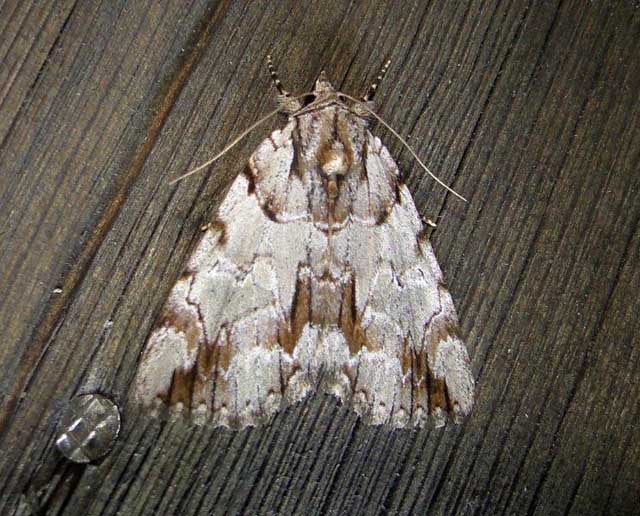
Catocala praeclara, Athol, Worcester County, Massachusetts,
July 15, 2011, courtesy of Dave Small.
SCENTING AND MATING:
Catocala praeclara females emit an airbourne pheromone and males use their antennae to track the scent plume.
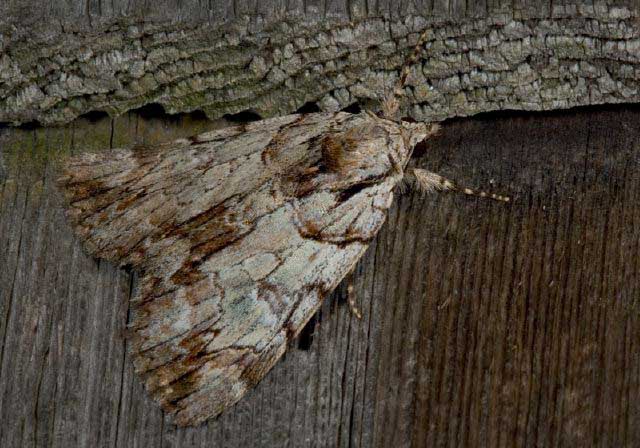
Catocala praeclara, Monhegan Island, Maine,
September 1, 2006, courtesy of Steve Nanz.
Visit Catocala praeclara, Omegaw County, Michigan, July 28, 2012, Cindy Mead
Visit Catocala praeclara, Florence, Hampshire County, July 16, 2014, Betsy Higgins.
EGGS, CATERPILLARS, COCOONS, AND PUPAE:
Eggs are deposited on tree/bush bark in the fall and hatch the following spring.
Larval Food Plants
Listed below are primary food plant(s) and alternate food plants. It is hoped that this alphabetical listing followed by the common
name of the foodplant will prove useful. The list is not exhaustive, although some species seem very host specific.
Experimenting with closely related foodplants is worthwhile.
Amelanchier
Crataegus
Crataegus calpodendron.......
Photinia
Photinia X prunifolia
Photinia melanocarpa |
Service berry/Juneberry/Shadbush
Hawthorn
Red haw/Pear hawthorn/Urn-tree haw
Photinia
Photinia
Black chokeberry
|
This page is brought to you by Bill Oehlke and the
WLSS. Pages are on space rented from Bizland. If you would like to become a "Patron of the Sphingidae/Catocala Sites",
contact Bill.
Please send sightings/images to Bill. I will do my best to respond to requests for identification help.
Enjoy one of nature's wonderments: Live Saturniidae (Giant Silkmoth) cocoons.

|

To show appreciation for this site, click on the flashing
butterfly to the left, a link
to many worldwide insect sites. |
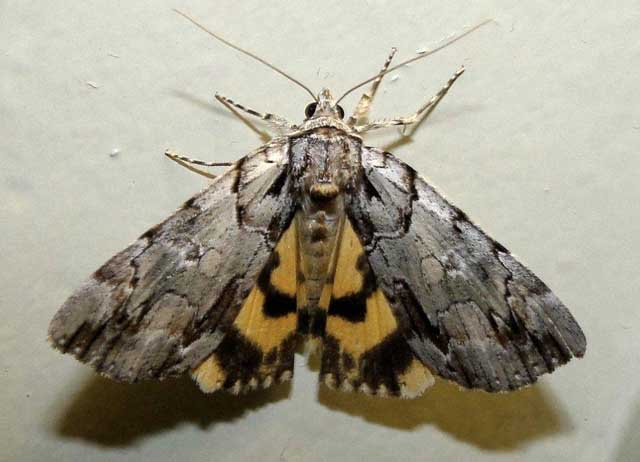
Catocala praeclara, Athol, Worcester County, Massachusetts,
August 2, 2011, courtesy of Dave Small.
I am often asked to identify Catocala, and had to carefully examine this specimen by actually writing a description of what I observe
before making a determination. There was some concern as to whether or not this might be Catocala mira, but my notes below, indicate why it is more likely
Catocala praeclara.
The Catocala depicted immediately above has an almost uniform ground colour of grey with a slight greenish cast. There is lighter grey (almost white) on the costa
from the body to about midpoint of median area where the costa gradually darkens to ground colour.
The basal area has three strong black dashes: one central, emanating from the body to about the middle of the basal area; the second running parallel
to the inner margin along one vein up from the inner margin from mid basal area to am line; the third emanating from the body, running along im almost to
antemedial line.
The amline is strong and dark in the costa, running almost obliquely before turning almost at a right angle near its midpoint, distant
from subreniform spot at this turn.
It turns again at a slightly oblique angle back toward the outer margin, before turnign again to the inner margin. The black outer edge is not as thick in the lower half of the line, and there is a strong
whitish presence interior to the aml in its lower half. The whitish inner lining is also present in the upper half, but is not as pronounced. There is much fainter, diffuse
light brown interior tracing of the whitish scaling.
The median area is pretty much devoid of markings except for a large, closed, subrectangular subreniform spot that is weakly outlined in
black and is slightly lighter than its surroundings. The reniform spot is a weakly delineated (very thin grey black outline) crescent with a whitish suffusion
surrounding the crescent.
The pmline is strong in its upper half to the completion of the two elongated teeth. Subsequent teeth are almost non-existant
until the third tooth which has its lower edge highlighted with a thick black streak, below which there is a dark brown bar, a thinner black steak on the next vein
and a brown area along the inner margin.
The subterminal area is a mix of light and dark brown and the terminal area shows some strong black highlights
on veins, and a row of white dots (appearing non-connected) subparallel to outer margin.
I looked at my description above and applied it to the other preaclara images on this page and found it to be an appropriate description, with some slight
variations, possibly due to angle, size, or quality of photos.
When applying the same description to mira, I find mira has a costa that lacks the lighter, whiter section near the body. Mira lacks the additional streaks in the
basal area. Ground colour is not as consistent in mira, and there is a definite lighter area in median area of mira from subreniform spot to costa
outside of amline. I also found the am line in mira gets very close to the lower inner edge of the subreniform spot. The dark steak in the lower reaches of the pm line is not so think in mira,
and the brown area along the inner margin is much weaker in mira. For all of the above, I feel this moth is more likely praeclara.
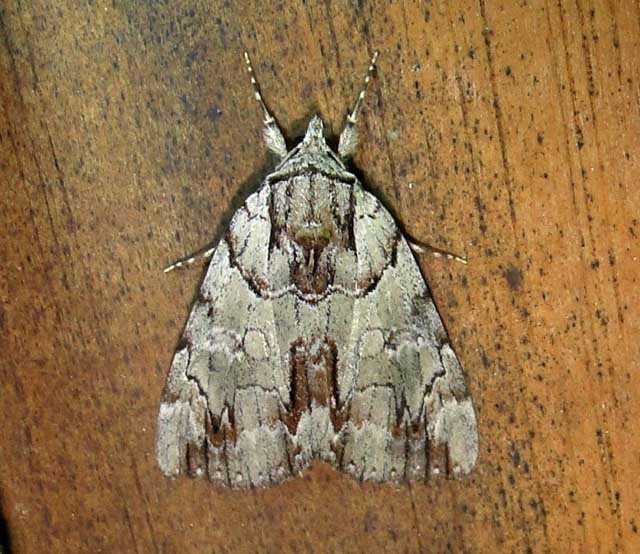
Catocala praeclara, Athol, Worcester County, Massachusetts,
August 2, 2011, courtesy of Dave Small.











